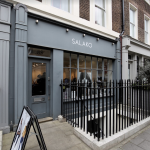Unprofitable? Yep, you heard it right. Launching a pop-up store doesn’t always have to translate into immediate profit, and that’s OK. The launch of a pop-up store is so valuable from various angles that a profit should not be your number one goal or even at the top of your list. If you set your expectations up right, the profits will eventually follow. We’ve listed below a few priorities to remember and trust us, before too long, the profits will roll in.
- Try It Before you Buy It
Consumers love to touch products, try products, and engage or interact with products before deciding to make their final purchase. A pop-up store doesn’t always translate to a consumer buying the product on the spot, but it allows that consumer to feel comfortable making that offline purchase when they please. Interacting with customers face-to-face allows retailers to have more direct influence on their buying decisions and the retailers can take advantage of the consumer feedback.

Luxury shoe brand, M.Gemi, was primarily an online brand, until it decided to invest in a pop-up store. At the pop-up store, consumers can try on as many of their luxurious shoes as they want and then have the shoes shipped to their doors. Anyone can walk-in and book a personalized VIP appointment. The employees are trained to educate the consumers and allow them to experience each style. Once you’ve tried on all you can take, order from the tablet, and off you go. A pop-up store experience should be more about the destination and what you are experiencing inside, without pressure to make a purchase. M. Gemi created a comfortable atmosphere for consumers to want to come in and with frequent new product drops, it gives another reason for that consumer to stop by.
There will always be something special about trying on a product, finding the perfect fit or the perfect color, and leave feeling confident about a purchase or the online purchase that you are seriously considering.
- Educate New Customers
A pop-up store allows direct engagement with customers, where you can not only grab their attention but also educate them on your product. Microsoft launched a series of pop-up stores across the US to educate consumers about the new Surface tablets. At the time, Microsoft was not known for its tablets and in order to get the product into consumers’ hands, they literally did just that and launched pop-up stores in heavy traffic areas. The idea was to educate consumers and allow them to engage and interact with the tablets. Whether they decided to purchase the product at the pop-up store or order it at a later time, the consumer now knows what to expect and feels confident with the purchase. By educating consumers in-person, they can see for themselves the features and value of the product.

A pop-up store is also helpful to drive pre-orders on a product and receive instant feedback on what the customer thinks. A live demo or a step-by-step on how to use a product gets consumers excited for the launch and reaches the early adopters who will ultimately spread the word.
- Unique Experiences

Pop-up stores can also get your product in the hands of consumers who haven’t had a chance to taste or experience it yet. Which brings us to experience. Experience is an important part of the pop-up store and it gives consumers something to take with them and remember.
One example of such an experience was when M&M’s candy brought in 3,000 attendees to its flavor experience event in New York. At the event, consumers sampled three new crispy flavors and voted for their favorite. There were three specialized rooms, one for each flavor. One of the rooms featured a giant espresso machine. This direct engagement with the consumer is a great way to get people excited and to boost brand awareness about a new product. M&M’s used the experience to get feedback from fans and have them vote on the next best flavor. A pop-up store should be used for consumer feedback, whether it’s completely interactive or not. It’s important to create an immersive experience for the consumer, something to photograph, something to take home. The idea is to ignite their senses and create an out-of-box experience.
[Also check out the M&Ms pop-up store in Times Square powered by Storefront!]
When the pop-up store is finished, it’s important to look at the exposure the brand received. The brand exposure at a pop-up store can be far more valuable than any dollar sign. The number of email addresses, new potential customers, or just people passing by and seeing the name will bring more success in the end than the profit or loss for one pop-up store.
- Why You Should Launch An Unprofitable Pop-up Store - October 18, 2018
- Why A Pop-Up Store Is The Best Content Creator - October 12, 2018
- 4 Reasons You Should Recommend a Pop-Up Store to Your Clients - October 1, 2018





